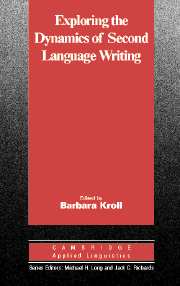Book contents
- Frontmatter
- Contents
- List of contributors
- Acknowledgments
- List of abbreviations used
- Series editors' preface
- Introduction: Teaching the next generation of second language writers
- I EXPLORING THE FIELD OF SECOND LANGUAGE WRITING
- II EXPLORING THE VOICES OF KEY STAKEHOLDERS:TEACHERS AND STUDENTS
- III EXPLORING WRITERS' FINISHED TEXTS
- IV EXPLORING CONTEXTUALITIES OF TEXTS
- Chapter 8 Genre and ESL/EFL composition instruction
- Chapter 9 Changing currents in contrastive rhetoric: Implications for teaching and research
- Chapter 10 Reading and writing relations: Second language perspectives on research and practice
- Chapter 11 Literature in the teaching of second language composition
- V EXPLORING TECHNOLOGY
- EPILOGUE: EXPLORING OURSELVES
- Index
Chapter 8 - Genre and ESL/EFL composition instruction
Published online by Cambridge University Press: 05 October 2012
- Frontmatter
- Contents
- List of contributors
- Acknowledgments
- List of abbreviations used
- Series editors' preface
- Introduction: Teaching the next generation of second language writers
- I EXPLORING THE FIELD OF SECOND LANGUAGE WRITING
- II EXPLORING THE VOICES OF KEY STAKEHOLDERS:TEACHERS AND STUDENTS
- III EXPLORING WRITERS' FINISHED TEXTS
- IV EXPLORING CONTEXTUALITIES OF TEXTS
- Chapter 8 Genre and ESL/EFL composition instruction
- Chapter 9 Changing currents in contrastive rhetoric: Implications for teaching and research
- Chapter 10 Reading and writing relations: Second language perspectives on research and practice
- Chapter 11 Literature in the teaching of second language composition
- V EXPLORING TECHNOLOGY
- EPILOGUE: EXPLORING OURSELVES
- Index
Summary
In everyday life, the word “genre” is used for many forms of expression in many contexts. Movie critics refer to certain types of films as “genres”; music fans talk about “rock and roll” and “rap” as “genres.” There are parodies of genres in a variety of art forms, and there are artists of all types who defy the established generic rules. In literacy studies throughout the world, “genre” has also become an increasingly popular term. In this chapter, I discuss how the term “genre” is currently used in composition studies, and how the various theories of genre influence approaches to classroom teaching, particularly as applicable in English as a second language/English as a foreign language (ESL/EFL) contexts.
History and definition of the term
With its many applications within our cultures, “genre” has a variety of historical roots. In academic settings, “genre studies” has traditionally referred to analyses of works of literature, such as different types of poetry, novels, and literary essays. In these analyses, conventions of form, style, characterization, plot structure, and other features that distinguish a particular genre are analyzed, as are variations in conventions within a single genre across time. Today, many literature departments still organize their courses around this concept and all that it implies.
Recently, the term “genre” has been used to capture the social nature of oral and written discourse by various theorists and practitioners from applied linguistics, especially those working in Systemic Functional Linguistics, English for Specific Purposes, and, in North America, the New Rhetoric, drawing from rich theoretical discussions (e.g., Bakhtin, 1986; Halliday, 1985; Miller, 1984; Swales, 1990).
- Type
- Chapter
- Information
- Exploring the Dynamics of Second Language Writing , pp. 195 - 217Publisher: Cambridge University PressPrint publication year: 2003
- 28
- Cited by

